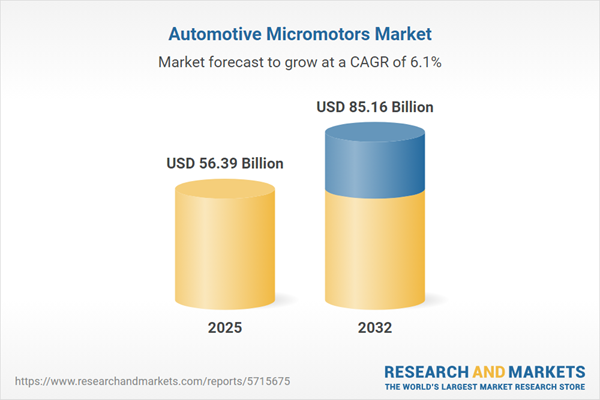Speak directly to the analyst to clarify any post sales queries you may have.
The automotive micromotors market is undergoing transformation as electrification accelerates, supply chains evolve, and compliance requirements increase. Senior executives in the sector require a strategic perspective that addresses key market trends, technology adoption, and optimal sourcing strategies to ensure operational agility and sustainable growth.
Automotive Micromotors Market Snapshot
The automotive micromotors market is experiencing strong compound annual growth, spurred by expanded applications and rising vehicle electrification. Micromotors have become foundational components for both passenger and commercial vehicles, serving as the essential interface between mechanical systems and digital automotive architectures. Their role is vital in enabling new vehicle features, advancing operational efficiencies, and driving innovations in energy management as digital transformation reshapes the industry. Energy efficiency, system integration, and space-saving designs remain front-of-mind for OEMs and aftermarket suppliers. The ongoing digitalization within vehicles is increasing the need for advanced control, connectivity, and seamless interaction between vehicle platforms and intelligent subsystems.
Scope & Segmentation—Automotive Micromotors Market
This executive report supports leaders in aligning technology planning and procurement strategy, building resilience to market volatility, and ensuring competitive readiness. Coverage is structured to be directly actionable for manufacturing, innovation, and operational teams.
- Motor Types: Analysis of AC, brushed DC, brushless DC, and stepper micromotors emphasizes operational benefits, levels of integration flexibility, and impacts on vehicle weight in both new and replacement applications.
- Distribution Channels: Reviews both OEM and aftermarket approaches, highlights lifecycle management, and evaluates local sourcing solutions that foster agile and responsive supply chains.
- Vehicle Types: Considers passenger vehicles, commercial fleets, and two-wheelers, detailing micromotor contributions in electrification and enhanced digital feature deployment.
- End Use Applications: Covers usage across comfort, infotainment, safety, and fuel systems, focusing on reliability, streamlined upgrades, and easing maintenance processes.
- Key Functional Applications: Provides insight into HVAC dampers, seat adjusters, window actuators, mirrors, and wipers, where precision and regulatory compatibility are essential for system optimization.
- Regional Coverage: Offers analysis across the Americas, Europe, Middle East, Africa, and Asia-Pacific, with targeted discussion on the United States, Germany, China, and India—covering local compliance, sourcing preferences, and domestic production strengths.
- Company Profiles: Presents strategic reviews of leading players: Nidec Corporation, Johnson Electric Holdings Limited, Mabuchi Motor Co., MinebeaMitsumi Inc., Maxon Motor AG, Portescap Inc., FAULHABER Group, Allied Motion Technologies, Brose Fahrzeugteile, and Ametek, Inc.
Key Takeaways for Senior Decision-Makers
- Brushless DC and stepper micromotors improve the adaptability and reliability of interior systems and vehicle subassemblies across diverse operational contexts.
- Adopting digital diagnostics and intelligent controls enables manufacturers and suppliers to optimize the functional lifespan and management of micromotor-driven platforms.
- Changing regulatory frameworks are compelling stakeholders to recalibrate sourcing models, underscoring the value of compliance, supplier diversification, and strong risk management practices.
- The aftermarket’s evolution, particularly toward modular and upgradable micromotor configurations, supports agile responses to regional compliance and operational needs.
- Material innovations, such as advanced composites and specialized magnets, are facilitating lighter and increasingly scalable solutions that align with next-generation efficiency targets and design constraints.
Tariff Impact on Supply Chain Strategy
Recent modifications to U.S. tariff policy have prompted automotive micromotor manufacturers to reassess sourcing and manufacturing strategies. As a result, companies are investing in regional production capabilities and expanding supplier networks to strengthen access to critical components like magnets and windings. The North American sector is especially focused on establishing resilient, adaptable manufacturing bases, while the aftermarket emphasizes flexible supplier partnerships to manage transition risks. These efforts are designed to maintain supply chain stability and mitigate global risk arising from trade and regulatory changes.
Methodology & Data Sources
Findings are based on primary interviews with OEM executives and suppliers, combining exclusive dataset analysis, patent literature review, and forward-looking scenario modeling to deliver actionable, executive-focused market intelligence.
Why This Report Matters
- Empowers senior teams to respond to evolving automotive micromotor technologies, shifting global regulations, and complex sourcing challenges.
- Delivers detailed segmentation and regional insights for more effective manufacturing planning and procurement strategies across both OEM and aftermarket domains.
- Supports risk mitigation with frameworks built to address supply chain uncertainty and global trade disruptions.
Conclusion
This report equips senior leaders with the analysis and tools necessary to steer investment, uphold compliance, and achieve supply chain agility as automotive micromotors become increasingly integral to the industry’s future.
Additional Product Information:
- Purchase of this report includes 1 year online access with quarterly updates.
- This report can be updated on request. Please contact our Customer Experience team using the Ask a Question widget on our website.
Table of Contents
3. Executive Summary
4. Market Overview
7. Cumulative Impact of Artificial Intelligence 2025
Companies Mentioned
The companies profiled in this Automotive Micromotors market report include:- Nidec Corporation
- Johnson Electric Holdings Limited
- Mabuchi Motor Co., Ltd.
- MinebeaMitsumi Inc.
- Maxon Motor AG
- Portescap Inc.
- FAULHABER Group
- Allied Motion Technologies, Inc.
- Brose Fahrzeugteile GmbH & Co. KG
- Ametek, Inc.
Table Information
| Report Attribute | Details |
|---|---|
| No. of Pages | 191 |
| Published | October 2025 |
| Forecast Period | 2025 - 2032 |
| Estimated Market Value ( USD | $ 56.39 Billion |
| Forecasted Market Value ( USD | $ 85.16 Billion |
| Compound Annual Growth Rate | 6.0% |
| Regions Covered | Global |
| No. of Companies Mentioned | 11 |









